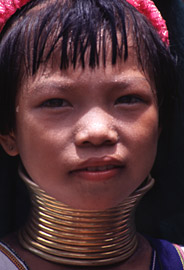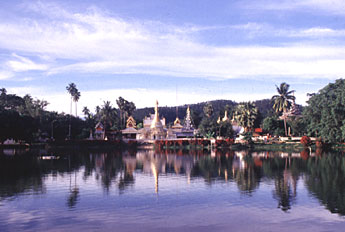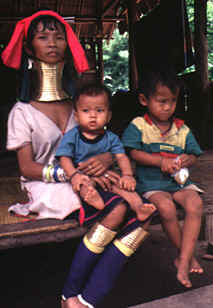Stretching One's Neck
For the Karen people living along the Thai-Burma border, where guerillas have been battling the army for half a century, it's dangerous to stick one's neck out. But one particular tribe finds it can be profitable: the evocative Pai Dong Long Neck People
By Ron Gluckman / Burma and Thailand
B
USINESS IS BUSTLING on both sides of the Pai River, a twisted waterway that serves the unstoppable flow of lumber and gems, mostly illegal, that amounts to a flourishing trade between Thailand and Burma. But our journey today is through the jungle to a treasure of a different
sort. We are risking our necks on elephants, then splashing down the dangerous
Pai River in search of the Pa Dong Karen, an almost mythical Burmese-Thai tribal
group better known by their nickname, the Long Neck Tribe.
But our journey today is through the jungle to a treasure of a different
sort. We are risking our necks on elephants, then splashing down the dangerous
Pai River in search of the Pa Dong Karen, an almost mythical Burmese-Thai tribal
group better known by their nickname, the Long Neck Tribe.
Women of the tribe have worn ornamental brass rings for centuries. Although the exact reasons have been lost in the myths of time, the end result is world famous. Like many tribes in Africa, they endeavor to stretch their necks, slowly, a ring at a time.
The Pa Dong Long Neck people, part of the larger Karen tribal group that lives along the Thai and Burmese border, make their home in a few simple villages. About three dozen of them live in Ban Nam Phiang Din, a remote Thai village on the Pai River.
We begin our journey in Mae Hong Son, a mountain town northwest of Chang Mai. We travel by truck into the Thai jungle before mounting elephants for a slow trek along muddy trails to the river. We sit side by side, two to a hard bench saddle. A guide sits on the elephant's head, and directs Dumbo by tugging his long ears. We rock back and forth through the jungle for a full hour before reaching the remote dock site.
 Another 30 minutes by boat takes us to a pair of metal-roofed huts, the last
stop before the river winds into Burma. Only one handwritten sign marks the
border. Two guards sit inside one hut, swatting big jungle flies and inviting us
to sign the guest book. Then, after a few cigarettes, one of the guards grabs
his gun and hops in the boat.
Another 30 minutes by boat takes us to a pair of metal-roofed huts, the last
stop before the river winds into Burma. Only one handwritten sign marks the
border. Two guards sit inside one hut, swatting big jungle flies and inviting us
to sign the guest book. Then, after a few cigarettes, one of the guards grabs
his gun and hops in the boat.
Although signs warn against crossing in Burmese and Thai, the actual border is 1-2 kilometers away. "But it's too dangerous to go any further," our guide confides.
Instead, our longtail boat motors back up river for a few minutes to the home of the Long Necks.
Rings are snapped around the necks of girls beginning at the age of six. A few rings may be added every year, up to a limit of 20. The record, according to one village woman, is 28 brass rings.
 The women's necks aren't actually stretched. Rather, the weight of the rings
gradually crushes the women's collar bones, producing the illusion of long
necks. At least, that's the official explanation. In person, the effect is
sufficiently striking to overwhelm thoughts of any rational explanation. The
necks seem eerily elongated. The women look like giraffes.
The women's necks aren't actually stretched. Rather, the weight of the rings
gradually crushes the women's collar bones, producing the illusion of long
necks. At least, that's the official explanation. In person, the effect is
sufficiently striking to overwhelm thoughts of any rational explanation. The
necks seem eerily elongated. The women look like giraffes.
They move around the village slowly, stopping to pose for tourist photos. Our guide explains that the women only remove the rings on their wedding night. Then, a long and elaborate process of neck washing ensues. Otherwise, the rings must remain in place, because the women's muscles can no longer support the neck alone.
The Long Neck women wear the colorful garb of northern Thai tribes people, white dress topped with scarves and hats in vibrant hues of red, blue and green. A few young girls also wear the brass rings, but the tradition seems to be dying out.
At the end of our visit, the women sell some trinkets, but without any insistence. The tourist dollars may keep these people alive, but they have their pride.
Ron Gluckman is an American reporter who is based in Hong Kong, but who roams around Asia for a number of publications, such as the South China Morning Post magazine, which ran this story.
To return to the opening page and index
push here
[right.htm]
